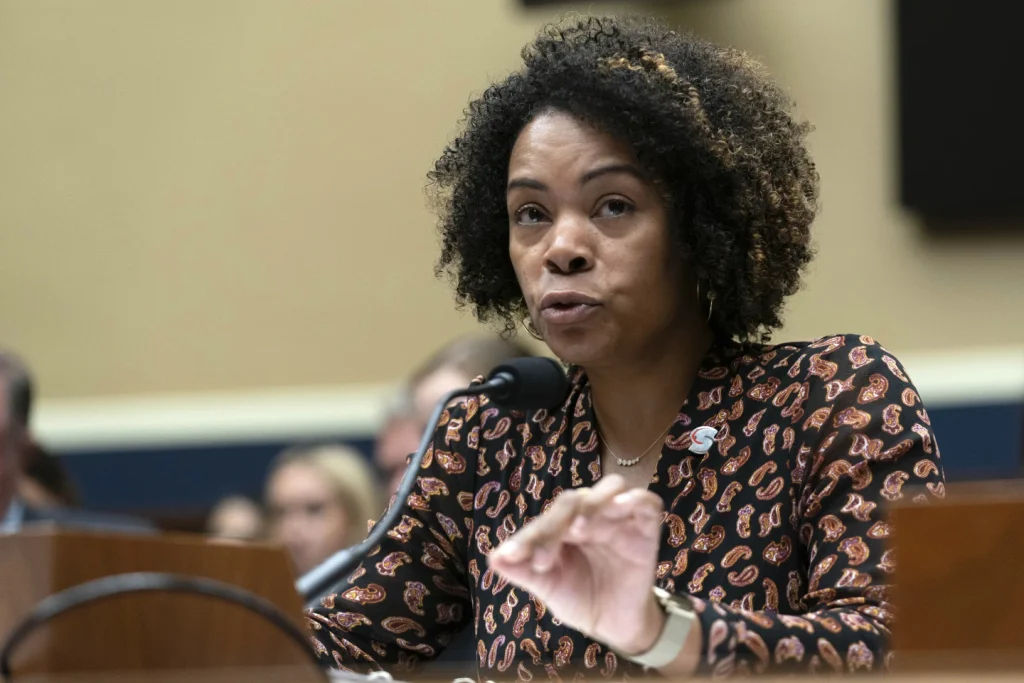The case of the 13-year-old swimmer, as reported by the Associated Press, has brought to light the complex and often challenging nature of addressing allegations of misconduct, particularly in the realm of youth sports.
The email from the U.S. Center for SafeSport, accusing the young athlete of engaging in sexual misconduct, has sparked a flurry of controversy and raised important questions about the handling of such sensitive matters.
The gravity of the accusations, juxtaposed against the age and innocence of the accused, underscores the need for a careful and thorough examination of the facts.
The email’s assertion that the swimmer had allegedly engaged in a pattern of behavior constituting sexual misconduct during the span of 2019 to 2022 is a weighty claim that demands meticulous scrutiny and fair treatment.
The specific incident in question, involving an alleged act of slapping a teammate on the buttocks in a locker room, has been the focal point of this protracted ordeal.
Despite local law enforcement’s swift dismissal of the case following an investigation, the cloud of uncertainty continues to loom over the young athlete.
The repercussions of these allegations, including the imposition of temporary sanctions by SafeSport, have cast a shadow over the swimmer’s burgeoning career and have undoubtedly taken a toll on his emotional well-being.
The impact of such allegations on a minor cannot be overstated. The psychological and emotional distress experienced by the accused individual, compounded by the public nature of the accusations, is a matter of grave concern.
The presumption of guilt that often accompanies such cases can have far-reaching implications, not only for the immediate future of the athlete but also for their long-term well-being and reputation.
It is essential to recognize the delicate balance that must be struck when addressing allegations of misconduct, particularly when minors are involved.
While it is crucial to prioritize the safety and well-being of all individuals within the sports community, it is equally important to ensure that the rights and dignity of the accused are upheld throughout the investigative process.
The prolonged duration of the case, extending over 20 months, underscores the need for a more expeditious and transparent approach to resolving such matters.
The toll that this extended period of uncertainty has exacted on the young athlete and his family cannot be overlooked.
The need for timely and judicious resolution is paramount, not only for the sake of the individual involved but also for the integrity of the entire investigative process.
The complexities inherent in addressing allegations of misconduct within youth sports highlight the imperative for clear and robust protocols that safeguard the rights of all parties involved.
The development of comprehensive guidelines that prioritize thorough investigation, fair treatment, and timely resolution is essential to ensure that such cases are handled with the utmost sensitivity and diligence.
In conclusion, the case of the 13-year-old swimmer serves as a poignant reminder of the multifaceted challenges inherent in addressing allegations of misconduct, particularly when minors are involved.
The need for a nuanced and equitable approach to such matters cannot be overstated. As this case continues to unfold, it is imperative that the rights and well-being of the accused young athlete are safeguarded, and that the investigative process is conducted with the utmost care and diligence.
Only through a steadfast commitment to fairness and justice can the sports community uphold its fundamental principles and ensure the protection of its young participants.
In summary, the case of the 13-year-old swimmer, as reported by the Associated Press, underscores the complexities and challenges inherent in addressing allegations of misconduct in youth sports.
The need for a careful, thorough, and equitable approach to such matters is paramount, and it is incumbent upon all involved parties to uphold the rights and well-being of the accused individual while ensuring a judicious and timely investigative process.
The establishment of the SafeSport Center in 2017 marked a pivotal moment in addressing abuse within Olympic sports, particularly in response to the harrowing Larry Nassar gymnastics molestation cases.
However, the center’s broad mandate, extending beyond the elite level to encompass various sports at the grassroots level, has brought to light significant challenges and implications.
This essay delves into the complexities and repercussions of SafeSport’s operations, particularly through the lens of a specific case, shedding light on the organization’s limitations and the impact on the individuals involved.
The case of a teen swimmer and his family serves as a poignant example of the difficulties faced within SafeSport’s investigative processes.
The mother’s account of delayed responses, lack of clarity, and a perceived “guilty-until-proven-innocent” approach underscores the profound frustrations experienced by those seeking resolution through the center.
The overtaxed investigative team, grappling with an overwhelming number of cases and a shortage of personnel, has led to prolonged timelines and an inability to provide concrete updates or reports, leaving affected individuals in a state of uncertainty and distress.
SafeSport’s operational challenges, including a $24 million annual budget, a staggering 7,000 complaints received in the previous year, and a relatively small team of 65 employees in its response and resolution department, raise critical questions about the organization’s capacity to effectively address the multitude of cases it confronts.
The lack of transparency, delayed responses, and the inability to provide firm timelines for case resolution not only impede the pursuit of justice but also erode trust in the organization’s ability to fulfill its mandate.

The repercussions of SafeSport’s limitations are acutely felt by the individuals directly affected by its decisions and processes.
The teen swimmer’s experience, culminating in restrictions placed upon his participation in USA Swimming events, reflects the tangible impact of the center’s actions.
The imposition of chaperoning requirements and the prohibition from interacting with the accuser not only curtailed the swimmer’s opportunities but also infringed upon his ability to pursue his passion and potential athletic achievements.
Moreover, the incident at a swim meet, where the swimmer was abruptly barred from competing in his best event due to a rule violation, underscores the profound ramifications of SafeSport’s decisions on the lives and aspirations of young athletes.
The mother’s poignant reflections, questioning whether SafeSport is overwhelmed, understaffed, or incompetent, prompt a critical examination of the ethical and organizational dimensions of the center’s operations.
The fundamental principles of fairness, due process, and timely resolution are brought into sharp focus, raising concerns about the center’s ability to uphold these values in practice.
Furthermore, the spokesperson’s acknowledgment that the responses provided to the family are inconsistent with the center’s values underscores the need for a comprehensive review of operational protocols and the adherence to core commitments to athletes and affected individuals.
The challenges and implications arising from SafeSport’s mandate, as exemplified by the case of the teen swimmer, demand urgent attention and scrutiny.
The organization’s operational limitations, the protracted investigative processes, and the tangible impact on athletes and their families underscore the need for a comprehensive reassessment of its capacity, responsiveness, and commitment to upholding fundamental ethical principles.
As the center continues to navigate the complexities of addressing abuse in Olympic sports, it is imperative to prioritize transparency, efficiency, and the well-being of those affected, ensuring that justice is not only pursued but also effectively delivered.
In the realm of sports, the issue of SafeSport has become increasingly prominent, with its mission to end abuse in sport extending beyond national teams and elite athletes.
However, the intricacies and challenges surrounding SafeSport investigations and their implications on individuals and their futures have come under scrutiny.
This essay aims to delve into the multifaceted nature of SafeSport concerns, drawing from a specific case to shed light on the complexities involved.
The narrative begins with an email exchange, where a concerned individual directs the accused party to seek resolution from the U.S. Center for SafeSport.
This simple act sets off a chain of events that encapsulate the intricate web of SafeSport proceedings and their far-reaching consequences.
The allegation of “bullying behaviors” against a young swimmer serves as the focal point of the case. However, the complexity deepens as it surfaces that prior exchanges of accusations of bullying had occurred between the involved parties, with interventions from educational institutions and swim clubs.
The involvement of SafeSport, therefore, raises questions about the efficacy of its interventions in cases that have already undergone scrutiny and resolution through other channels.
The accuser’s mother’s acknowledgment of filing a report on behalf of her son adds another layer to the narrative.
The lack of response to interview requests further shrouds the case in ambiguity, leaving room for speculation about the motivations and perspectives driving the allegations.
A pivotal revelation emerges when it is disclosed that it was the local police department, not SafeSport, that initially shed light on the alleged episode.
The subsequent dismissal of the case by the police department raises questions about the varying standards of proof and investigative approaches between law enforcement and SafeSport.
The divergence in decision-making processes and standards of evidence underscores the complexity of navigating allegations in the realm of sports-related misconduct.
The CEO of the SafeSport Center, Ju’Riese Colon, emphasizes the center’s commitment to addressing grassroots cases and its mission to end abuse in sport.
The surge in the number of allegations received in recent years highlights the growing demand for SafeSport’s intervention and the strain it places on the organization’s resources.
The plea for additional financial support underscores the magnitude of the challenges faced by SafeSport in fulfilling its mission effectively.
A critical juncture in the narrative arises when the accused teen is offered an “informal resolution” by SafeSport, presenting an opportunity to return to swimming with a six-month probation upon admitting to the alleged offense.
The refusal of the accused to confess to an act he claims he did not commit underscores the ethical and moral dilemmas faced by individuals embroiled in SafeSport investigations.
The implications of such decisions on the accused individual’s future in sports and academic pursuits loom large, adding to the weight of the situation.
The essay concludes with an exploration of the lingering concerns and frustrations voiced by the accused teen and his family.
The impact of the unresolved or potentially resolved case on the teen’s future in swimming and college recruitment becomes a source of anxiety and distress.
The enduring repercussions of the SafeSport case underscore the lasting effects of such investigations on the lives and aspirations of individuals involved.

In essence, the case presented underscores the intricate and often convoluted nature of SafeSport concerns, raising pertinent questions about the efficacy, fairness, and impact of its interventions.
As the realm of sports continues to grapple with issues of misconduct and abuse, a nuanced understanding of the complexities surrounding SafeSport becomes imperative in fostering a climate of accountability, fairness, and support for all individuals involved.
In conclusion, the case serves as a poignant illustration of the multifaceted challenges inherent in SafeSport proceedings and their profound implications on the lives and aspirations of individuals.
It calls for a deeper examination of the mechanisms, standards, and support systems in place to ensure the equitable and just resolution of SafeSport concerns, thereby safeguarding the well-being and futures of those embroiled in such investigations.
